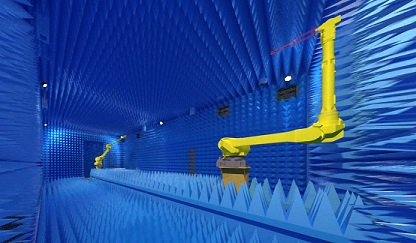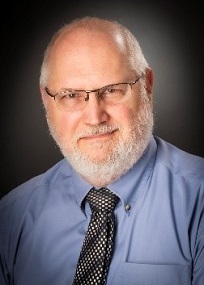Modern Antenna and Electromagnetic Measurements: Half-Day LIVE & IN-PERSON Workshop
The IEEE Seattle EMC and Vancouver BC Joint Chapters are Proud to Announce an IN-PERSON Event with FOUR EMC and Antenna Experts - Complemented by a Unique Tour at the Seattle Museum of Flight. Join us for a Half-Day Workshop!
All IEEE members and non-members are welcome to attend this FREE event, provided you register in advance. Seating is strictly limited and registrations will be accepted until space is full.

Join us for a complimentary lunch sponsored by SteppIR and Advanced Test Equipment Corp (ATEC). Following lunch, attendees will hear FOUR experts present on modern antenna and electromagnetic measurements to boost your test efficiency, reliability, and repeatibility. In addition to the two presentations shown below, this half-day event also features speakers Zhong Chen with ETS-Lindgren and Dennis Lewis with Boeing.
Mr. Chen will present "Site VSWR for Anechoic Chamber Performance Evaluation – Past, Present, and Future"
Mr. Lewis will present "Complex Cavity Measurement Techniques for the Assessment of Aircraft Electromagnetic Environments"
Following the presentations, Dr. Kent will present a Private Lecture at the Museum of Flight on a few key US aircraft spanning 1935-1960, many of which involved game changing technologies for their day. Within time constraints, we’ll visit some key fighters (P-38, P-51, F-14 Tomcat) and bombers (B-17, B-29, B-47) as well as the SR-71, which fielded the first stealthy technologies. Did you know for instance that the B-29 was so advanced it had over 100 separate patents including the first airborne analog computer system! Did you also know that the re-engined B-50 Superfortress became Lucky Lady II, the first aircraft to fly around the world non-stop, during a 94-hour flight in 1949? Learn about the fascinating story behind these engineering marvels from an aeronautical expert and noted storyteller, Dr. Brian Kent. Wear comfortable walking shoes!
Workshop attendees are free to attend this group tour OR visit any of the open exhibits on your own at the Museum of Flight until the 5:00 pm closing time. Access to the Museum of Flight is provided at no charge to all registered workshop attendees who are wearing the museum wristband provided upon arrival.
VIEW THE REGISTRATION PAGE FOR ALL PRESENTATION ABSTRACTS AND SPEAKER BIOS
WARNING: Potential Health Risks The Museum of Flight Foundation (the "Museum") and the IEEE EMC Chapters are taking steps to protect the health of attendees at this Event on Sept 13, 2021. Notwithstanding these efforts, the Museum and IEEE EMC Chapters cannot give assurances to attendees at the Event that no attendee will contract Covid-19 or any other illness as a result of attending the Event. Please understand that by attending the Event, you are willingly taking a risk to your health, including the risk of possible exposure to Covid-19 or another virus or illness.
Note Covid protocols will be followed, including generously spaced classroom seating. Proof of vaccination or face mask is required. Attendance is strictly limited so register early to secure your space.
Date and Time
Location
Hosts
Registration
-
 Add Event to Calendar
Add Event to Calendar
- The Museum of Flight Seattle
- 9400 East Marginal Way South
- Seattle, Washington
- United States 98108
- Room Number: Skyline Room, 2nd Floor
- Contact Event Hosts
-
Questions? Contact Janet O'Neil, j.n.oneil@ieee.org
Speakers
 Dr. Brian Kent of Applied Research Associates (ARA)
Dr. Brian Kent of Applied Research Associates (ARA)
Return-to-Flight Electromagnetic Measurements - The NASA Shuttle Ascent Debris Radar System
Keynote Presentation: The NASA Debris Radar (NDR) system was developed to characterize ascent debris liberated during the Shuttle’s ascent into space. Radar is well suited for characterizing ascent debris and is essential during night launches when optical sensors are severely degraded. The NDR mission presents challenging radar requirements in terms of target detection, tracking, minimum detectable radar cross-section (RCS), calibration accuracy, power profile management, and operational readiness. After revisiting the Columbia accident investigation, I describe the NDR system, consisting of a stationary C-band radar located at Kennedy Space Center and two sea-based X-band radars. During the 3 year development effort, the NDR team examined static and dynamic radar signatures of the shuttle and liberated debris, and executed an “in-situ” Electromagnetic Interference Measurement on the Orbiter “Discovery” to certify its safety from radar EMI. Since Shuttle Mission Managers needed definitive safety assessments within 24-30 hrs of launch, analysis tools and software provided shuttle metric data in real-time, visualize metric and signature data during post-mission analysis, automatically detect and characterize debris tracks in signature data, determine ballistic numbers for detected debris objects, and assess material type, size, release location and threat to the orbiter based on radar scattering and ballistic properties of the debris.
Biography:
Dr. Brian M. Kent joined Applied Research Associates (ECD, Fairborn, Ohio office) as Senior Scientist and S&T Lead for Electro-magnetics (EM), Radio Frequency (RF), and Sensing Systems. ARA is an employee-owned scientific research and engineering company founded in 1979 and dedicated to producing innovative solutions that tackle critical national problems in National Security, Infrastructure, Energy and Environment, and Health Solutions. (www.ARA.com). Dr. Kent supports corporate ARA technical efforts and works to expand S&T opportunities in his area of expertise. Prior to joining ARA, Dr. Kent was the Chief Technology Officer, Air Force Research Laboratory (AFRL), Wright-Patterson Air Force Base, Ohio. He served as AFRL's principle scientific/technical advisor and primary authority for the technical content of the Science and Technology Portfolio. He evaluated the total Laboratory technical research program to determine its adequacy and efficiency in meeting national, DoD, USAF, AFMC, and AFRL objectives in core technical competency areas. He also collaborated on numerous interdisciplinary research problems that encompassed multiple AFRL directorates, customers from other DOD components, as well as the manned space program managed by NASA. Dr. Kent is a Fellow of the Institute of Electrical and Electronics Engineering (IEEE) and an international IEEE Distinguished Lecturer for the Antenna and Propagation Society. He is also a Fellow of the Antenna Measurement Techniques Association and of the Air Force Research Laboratory. He was a 2009 Meritorious Presidential Rank Awardee. His technical specialties include EM Scattering and Material Property Measurements, Radar, Antenna, and Radar Cross Section Measurements, Radar Performance Evaluation, RF/EO Sensing Technologies, and Passive/Active Electronic Warfare.
Address:Fairborn, Ohio, United States
 Dr. Randy Jost of Consultant
Dr. Randy Jost of Consultant
Protection of Aerospace Systems from Lightning (and other Electromagnetic Threats): An Overview
Aerospace manufacturers expend a significant amount of time during the design and testing process ensuring the proper operation of their platforms and systems in typical and adverse electromagnetic environments. Electromagnetic environmental effects also known as E3 or E-cubed are both ubiquitous and diverse. The adverse electromagnetic environment that most people are familiar with is lightning, and chances are, if you fly frequently, you have been or will be in an aircraft that has been hit by lightning, and may not even be aware of it. However, there are other electric, magnetic and electromagnetic phenomena that can cause problems to aerospace platforms, both on the ground and in the air, such as triboelectric charging, precipitation static or P-Static, electromagnetic pulse (EMP) and High Intensity Radiated Fields (HIRF). This presentation provides an overview of the protection of aerospace systems from lightning and other electromagnetic effects. Starting with a brief introduction to the sources of electromagnetic events that can cause interference with the proper operation of an aerospace platform, we will examine how electric, magnetic and electromagnetic signals can interact with platforms and systems. Both direct and indirect effects will be addressed. After the introduction to EME sources, we will cover many of the ways that protection is built into the modern aerospace platform, including those made of composite materials, where the usual Faraday Cage protection approach has to be modified. Also to be addressed is the protection of key systems and subsystems, such as the weather radar and its associated radome, avionics, and fuel sensors. A key takeaway from this presentation is that EMC and protection of the aerospace platform must be designed in from the start, an integrated design approach should be used, and that there are significant trade-offs that must be negotiated to obtain a balance between performance, protection, SWAP and price.
Biography:
Dr. Randy J. Jost has worked in academia, industry, the US government, the US military and been a consultant. He received the BSEE (1978), MSEE (1980), and Ph. D. in EE (1988) from the University of Missouri-Columbia. He served as an officer in the USAF (1982-2006), and retired from the Air Force as a Lieutenant Colonel in 2006. For more than 25 years, he has developed calibration and measurement procedures to accurately and verifiably measure the signatures of components, subsystems, and platforms for aerospace systems. He recently retired from his position at Ball Aerospace as a Staff Consultant in electromagnetic compatibility (EMC) where he provided company-wide support in EMC/EMI technologies as well as in-house training on EMC design and testing for aerospace systems. Currently, he is a consultant and teaches short courses in several topic areas, including EMC, Radar, and Optical Sensors. Dr. Jost is a Life Senior Member of the IEEE and has served in many positions in the EMC Society, including a term on the Board of Directors and is active in both the EMC and AES Societies, serving on several committees and reviewing papers for both groups. He is a Senior Member of the Antenna Measurement Techniques Association, and has served on the AMTA Board of Directors. He is also a member of the Association of Old Crows and SPIE. He was a licensed professional Engineer in the state of Virginia, and is an iNARTE certified EMC Engineer, an iNARTE certified Spectrum Management Engineer, a licensed Commercial Radio Operator, and a Licensed Amateur Radio Operator, Extra Class (N8NAZ).
Address:Hyde Park, Utah, United States
Agenda
All times are Pacific Daylight Time
12:00 pm Check-in and Complimentary Buffet Lunch
12:45 pm Welcome and Announcements – Mr. Dennis Lewis, Technical Fellow, The Boeing Company, Seattle, WA; Chair, IEEE EMC Society Seattle Chapter
12:50 pm KEYNOTE PRESENTATION: Return-to-Flight Electromagnetic Measurements - The NASA Shuttle Ascent Debris Radar System – Dr. Brian M. Kent, Chief Scientist, Applied Electromagnetics Division, Applied Research Associates
1:50 pm Site VSWR for Anechoic Chamber Performance Evaluation – Past, Present, and Future – Mr. Zhong Chen, Director of RF Engineering, ETS-Lindgren, Cedar Park, TX
2:30 pm REFRESHMENT BREAK
2:50 pm Complex Cavity Measurement Techniques for the Assessment of Aircraft Electromagnetic Environments – Mr. Dennis Lewis, Technical Fellow, The Boeing Company, Seattle, WA; Chair, IEEE EMC Society Seattle Chapter
3:20 pm Protection of Aerospace Systems from Lightning (and other Electromagnetic Threats): An Overview – Dr. Randy J. Jost, Consultant, Hyde Park, UT
4:00 pm Museum of Flight Special Tour with Dr. Brian Kent
5:00 pm Wrap Up/Final Comments
All IEEE members and non-members are welcome to attend this FREE event, provided you register in advance. Seating is strictly limited and registrations will be accepted until space is full. Register at https://www.eventbrite.com/e/modern-antenna-and-electromagnetic-measurements-tickets-166887321471

